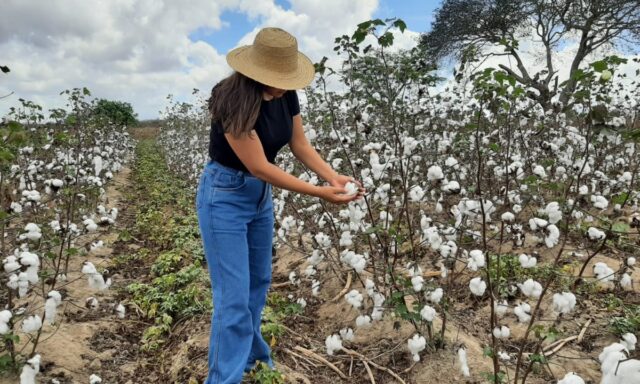More sustainable fashion is not a big deal, much less a distant dream. It is a fact that the pace currently imposed – that of fast fashion – dictates the complete opposite of fashion that preserves the environment and people. But there are ways to produce and consume responsibly. And there is also a public decided to give their money to companies that are more socio-environmentally responsible. In other words, it is a situation win-winin which both sides benefit.
Companies are charged, or “cancelled”, for their socio-environmental impacts. And no wonder: the green makeup (or greenwashing) has not been able to escape the reality of global warming. It’s hard to know that we are going to celebrate Amazon Day, September 5th, and Cerrado Day, September 11th, with the respective biomes on fire, for example.
Drought, strong winds and heat have transformed Brazilian biomes into powder kegs, declared the Environmental Satellite Applications Laboratory at the Federal University of Rio de Janeiro (Lasa/UFRJ). Faced with this, the fashion sector can collaborate to make ecosystems more resilient – and as humans and nature are interconnected, such actions also bring resilience to vulnerable populations.
Starting with the basics: the use of natural raw materials. By dispensing with the use of synthetic fibers, such as polyester, nylon, elastane, polyamide, which originate from oilthere is a range of other options that, produced respecting the limits of nature, become more environmentally friendly. And they go beyond agroecological cotton, such as: hemp, buriti, tucum, tururi.
Traditional cotton and BCI cotton also do not have good ecological footprintas they use a large amount of pesticides. Both, in fact, are the same: produced in the rotation of commodities such as corn and soybeans, they are linked to illegal deforestation and the contamination of the environment and people – cotton is the 4th culture which uses the most pesticides in Brazil.
Therefore, change begins from the first seed that is planted and cultivated. Pesticides are not only used to repel insects, but also to increase crop productivity, in order to sell more of the commodity. In other words, what traditional cotton and BCI cotton do is not respect the rhythm of nature, because a land that produces more in an unnatural way is a land that will wear out more and will need more chemicals to continue producing.
The Earth can no longer keep up with the pace of global production. It is no wonder that the Earth Overshoot Day is reduced each year. In 2023, it was on August 2nd and, this year, on the 1st. The date marks the day on which humanity consumes all the natural resources that the planet can produce or renew in a year. Therefore, to create a sustainable product, the fashion industry also needs to respect nature’s time.
Fashion that respects everyone
By respecting nature, we are also respecting people. Node Piauíorganic cotton transforms quilombola backyards and the Caatinga. Already in Tothe Aldeia Tukaya Indigenous Association – AITEX, from the Xipaya Indigenous Land, uses latex, annatto, seeds and feathers to produce biojewelry, bags and backpacks. Using modern industrial equipment and ancestral techniques, the businesses – today called “bioeconomy” – provide appreciation for Brazil’s cultural wealth.
Decentralized fashion is fashion that brings different faces, different materials, that recognizes, for example, that there are different Amazonian realities. It is also a continuous work, that is, it is not limited to a special collection from a major brand in the Southeast with communities and associations in the interior of the country. One-off jobs bring occasional income to workers who will continue to be excluded from the big names in magazines and catwalks – bringing the name of those who make your clothes is, in fact, one of the struggles of Fashion Revolution.
Which brings us to another point: the transparency. Fundamental to socio-biodiversity, transparency ensures that production stages are evaluated not only by companies, but also by third parties, to certify that, for example, that cotton did not come from illegally deforested land. Recognizing those who make your clothes means bringing dignified conditions to workers in the sector and also preventing companies from pretending to be something they are not.
Traceability combines with transparency to form this duo that guarantees fashion a fairer production for everyone. Traceability certificates are already common in sectors with large and dispersed production lines, such as fashion. This is the case with coffee and fresh and processed fruits.
Another important point, raised by “Sustainable Fashion Communication Manual”is the definition of clear climate and environmental goals. The document was prepared by the United Nations Environment Program (UNEP) and UN Climate Change and points out that “brands and designers are being encouraged to establish measurable goals, such as reducing carbon emissions, using recyclable materials and the elimination of waste of resources”.
The Brazil Fashion Transparency Index 2023 also brought, for the first time, the commitment of brands to climate goals, such as energy consumption by supplier installations, production still powered by coal and commitments and investments in decarbonization.
Based on this, the document highlights that 22% of the brands surveyed publish measurable, time-bound goals for reducing textile products derived from virgin oil. “If companies do not share this strategy, there is no visibility to demand that they comply with the decarbonization commitment that they have established”, he informs.
The fashion industry can contribute a lot to boost or harm the preservation of Brazilian socio-biodiversity. She must assume her responsibilities and make the slow fashionfashion that respects the time of nature and people, its norm. On the day to celebrate the Amazon and the Cerrado, let’s fight for them. Whether for the creation of new laws within the sector, or in socio-environmental struggles, as in the case of marco temporal and no Pack of Destruction.






